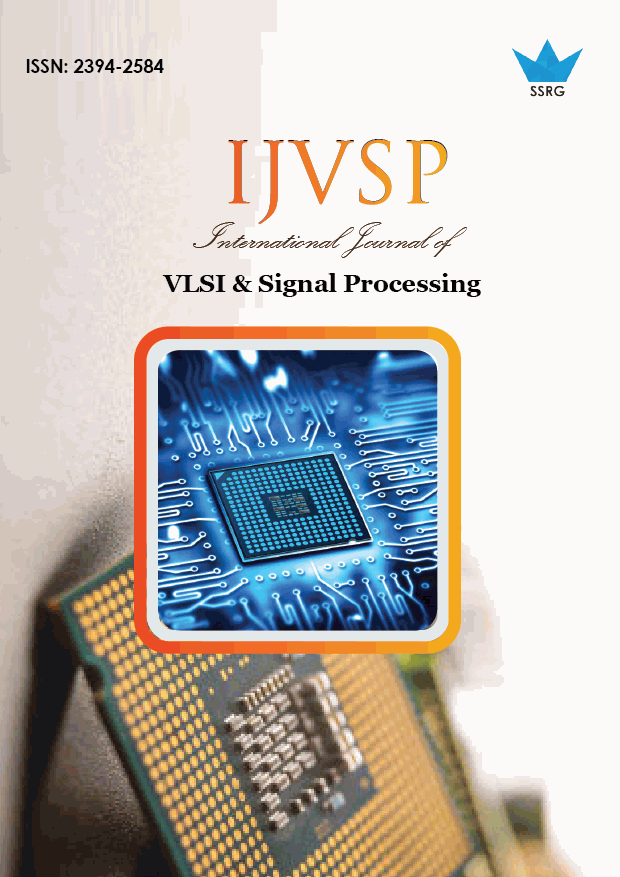Parametric Variations of Transistor Doping Profiles for Ultra Low Power Applications

| International Journal of VLSI & Signal Processing |
| © 2018 by SSRG - IJVSP Journal |
| Volume 5 Issue 3 |
| Year of Publication : 2018 |
| Authors : Xhino M. Domi, Emadelden Fouad and Muhammad S. Ullah |
How to Cite?
Xhino M. Domi, Emadelden Fouad and Muhammad S. Ullah, "Parametric Variations of Transistor Doping Profiles for Ultra Low Power Applications," SSRG International Journal of VLSI & Signal Processing, vol. 5, no. 3, pp. 23-27, 2018. Crossref, https://doi.org/10.14445/23942584/IJVSP-V5I3P103
Abstract:
The VLSI industry is facing the significant parasitic effects that creates a serious problem for further development in the nanoscale domain. However, instead of replacing the traditional MOSFET design, it would be more advantageous to apply different doping profiles for ultra-low power applications. With a comprehensive review of Gaussian doping, Uniform doping, and Delta doping profiles and analysis of the FET technology characteristics that use these doping profiles, a comparison can be made among them for integrated circuit design engineers. These doping profiles are compared based on how well they perform between non-ideal and ideal environments. Also, both digital and analog performance parameters are measured to ensure the uniqueness of each doping profile. After getting a list of benefits from each doping profile that is presented in this paper, it is concluded to determine which doping profile works best against a host of parasitic effects. Finally, this paper also conclude that what type of possible applications do these doping profiles.
Keywords:
Subthreshold Swing, Uniform Doping, Gaussian Doping, Delta doping, and Ultra Low Power.
References:
[1] V. A. K. Temple, "Ideal FET doping profile," in IEEE Transactions on Electron Devices, vol. 30, no. 6, pp. 619-626, June 1983. doi: 10.1109/T-ED.1983.21180.
[2] H. J. M. Veendrick, "Short-circuit dissipation of static CMOS circuitry and its impact on the design of buffer circuits," in IEEE Journal of Solid-State Circuits, vol. 19, no. 4, pp. 468-473, Aug 1984. doi: 10.1109/JSSC.1984.1052168.
[3] D. W. Feldbaumer and D. K. Schroder, "MOSFET doping profiling," in IEEE Transactions on Electron Devices, vol. 38, no. 1, pp. 135-140, Jan 1991. doi: 10.1109/16.65747.
[4] P. G. Young, R. A. Mena, S. A. Alterovitz, S. E. Schacham and E. J. Haugland, "Temperature independent quantum well FET with delta channel doping," in Electronics Letters, vol. 28, no. 14, pp. 1352-1354, 2 July 1992. doi: 10.1049/el:19920858.
[5] C. H. Wann, K. Noda, T. Tanaka, M. Yoshida and Chenming Hu, "A comparative study of advanced MOSFET concepts," in IEEE Transactions on Electron Devices, vol. 43, no. 10, pp. 1742-1753, Oct 1996. doi: 10.1109/16.536820
[6] Wolpert, David, and Paul Ampadu. “Temperature Effects in Semiconductors.” Managing Temperature Effects in Nanoscale Adaptive Systems, 2011, pp. 15–33., doi:10.1007/978-1-4614-0748-5_2.
[7] A. Nandi, A. K. Saxena and S. Dasgupta, "Analytical Modeling of a Double Gate MOSFET Considering Source/Drain Lateral Gaussian Doping Profile," in IEEE Transactions on Electron Devices, vol. 60, no. 11, pp. 3705-3709, Nov. 2013. doi: 10.1109/TED.2013.2282632.
[8] Ramesh, R., et al. “Optical Effects on the Characteristics of GaAs Nanoscale FinFET with Vertical Gaussian Doping Profile.” Optik - International Journal for Light and Electron Optics, vol. 124, no. 19, 2013, pp. 4019–4025., doi: 10.1016/j.ijleo.2013.02.007.
[9] Gowri, K., and V. Rajamani. “Optical Effects on the Characteristics of a Nanoscale SOI MOSFET with Uniform Doping Profile.” Optik - International Journal for Light and Electron Optics, vol. 125, no. 13, 2014, pp. 3195–3200., doi: 10.1016/j.ijleo.2014.01.025.
[10] Mohanty, S.s., et al. “Effect of Delta Doping on the RF Performance of Nano-Scale Dual Material MOSFET.” Procedia Computer Science, vol. 57, 2015, pp. 282–287., doi: 10.1016/j.procs.2015.07.485
[11] X. A. Cao, X. M. Li, S. Li and L. Y. Liu, "Conductivity Enhancement in Organic Electronics by Delta Doping," in IEEE Electron Device Letters, vol. 37, no. 12, pp. 1628-1631, Dec. 2016. doi: 10.1109/LED.2016.2620184
[12] Dash, Sidhartha, et al. “Improved Cut-off Frequency for Cylindrical Gate TFET Using Source Delta Doping.” Procedia Technology, vol. 25, 2016, pp. 450–455., doi: 10.1016/j.protcy.2016.08.131.
[13] Sood, Himangi, et al. “Performance Analysis of Undoped and Gaussian Doped Cylindrical Surrounding-Gate MOSFET with Its Small Signal Modeling.” Microelectronics Journal, vol. 57, 2016, pp. 66–75., doi: 10.1016/j.mejo.2016.10.001
[14] Singh, Kunal, et al. “Subthreshold Current and Swing Modeling of Gate Underlap DG MOSFETs with a Source/Drain Lateral Gaussian Doping Profile.” Journal of Electronic Materials, vol. 46, no. 1, 2016, pp. 579–584., doi: 10.1007/s11664-016-4914-6
[15] Hossain, Munem, and Masud H. Chowdhury. “Comprehensive doping scheme for MOSFETs in ultra-Low-Power subthreshold circuits design.” Microelectronics Journal, vol. 52, 2016, pp. 73–79., doi: 10.1016/j.mejo.2016.03.007

 10.14445/23942584/IJVSP-V5I3P103
10.14445/23942584/IJVSP-V5I3P103